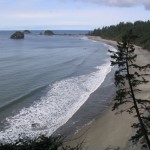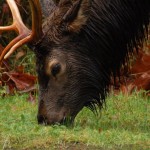There are flowers present in Olympic National Park throughout the year; the trick is finding them when and where they bloom. The Park has a number of climatic zones between near sea level and alpine rock and ice, generally above 6,500 feet of elevation. The Park’s terrain has an extensive array of steep ridges, which results in differences in sunlight and heat gain, particularly in the spring, when the sun is still relatively low on the horizon. Slopes that face east and north are adversely affected—and so are home to fewer flowering plants—while those on the south and west provide a better growing environment for flowering plants. Flowering plants rarely bloom in or under snow cover, but there are exceptions, such as Glacier and Avalanche Lilies which spring to life as soon as the snow cover thins sufficiently to allow them sunlight.
When plants bloom and how long they stay in bloom can be a function of available water. In river valleys and some mountain valley meadows, the retention of water in the soils—or the passage of water through the soils—extends the blooming season. On high ridges, like Hurricane Ridge, snow melt drains rapidly from the thin soil into the loosely compacted rock rubble called breccia. In the high country of the Park, the plant cycle of sprouting, budding, blooming and dying back happens in a hurried several weeks. If this isn’t confounding enough, flowers like Saxifrage seem to grow right out the rocks. Spring is a relative occurrence in the Park, dictated by location and the winter snow’s release of the land. Starting in the lowlands in March, spring arrives in the sub-alpine meadows much later, in mid-July, and sometimes lasts all the way through August for a few of the hardiest species.
There are a variety of flowers nearly everywhere in the Park, and often several varieties appear in the same locations. Green Hellebore, with its tassel-like heads, is often found sharing a damp sub-alpine meadow with Cow Parsnip, Sitka Valerian and Lupine. Along forest trails Canadian Dogwood, Trillium and Queens Cup are neighbors awaiting a visit. In rocky areas and on open rock faces, look for Stonecrop, Phlox, Harebell or Piper’s Bellflower. Scarlet Paintbrush makes its appearance in open areas at all elevations until the soil gives itself over to rock and ice. Pink Coast Rhododendrons are a common sight at low elevations along roads and trails throughout the Park. In addition to being the Washington State Flower, they are the cousins of the less seen White Rhododendron found in open, moist sub-alpine areas, such as Sunnybrook Meadows below Constance Pass, on the east side of the Park. For the hard-to-satisfy visitor, several flowers are among endemic plants found nowhere else on earth: the Olympic Violet, and the Olympic Rock Mat are examples.
Seeking specific wildflowers is the activity of choice for some visitors, well-equipped with Flower guidebooks and a camera, while viewing flowers is a universal experience for nearly everyone who visits the Park. From acres of sub-alpine meadows carpeted in bloom to easy walks in the rain forest, there are flowers enough for everyone. But please, mind your step; those that follow will be grateful for your caring.
The following web sites will be useful in demonstrating the variety of flowers to be found in the Park:



